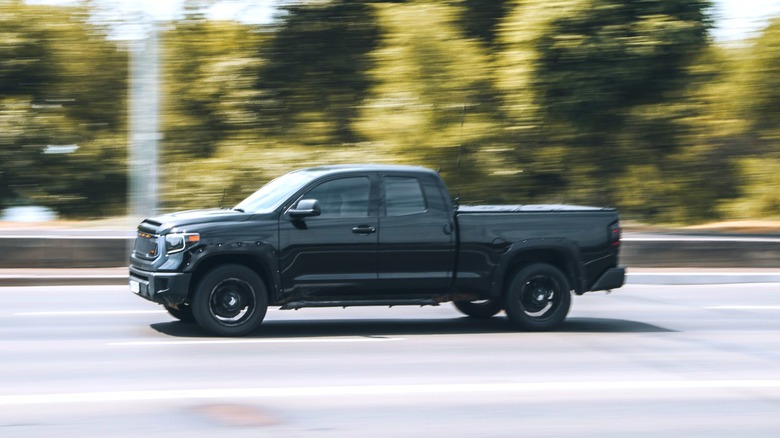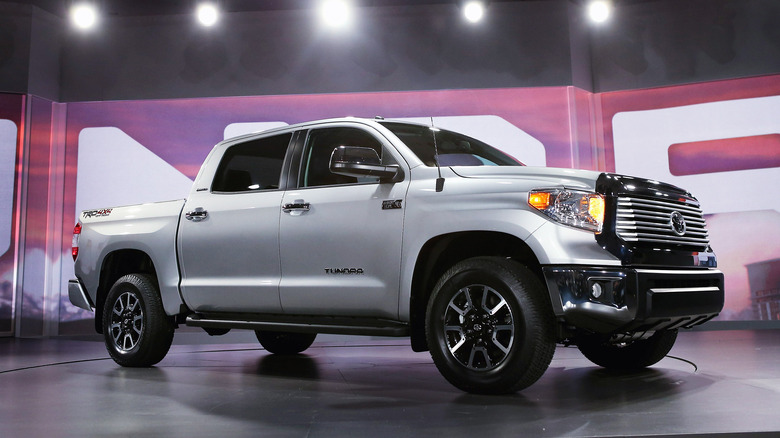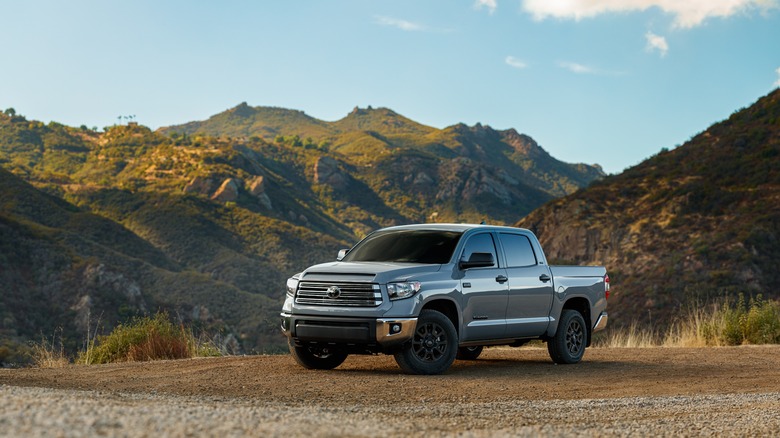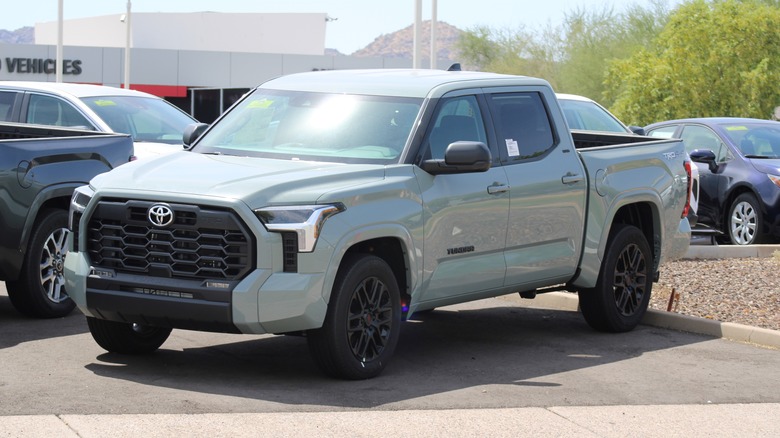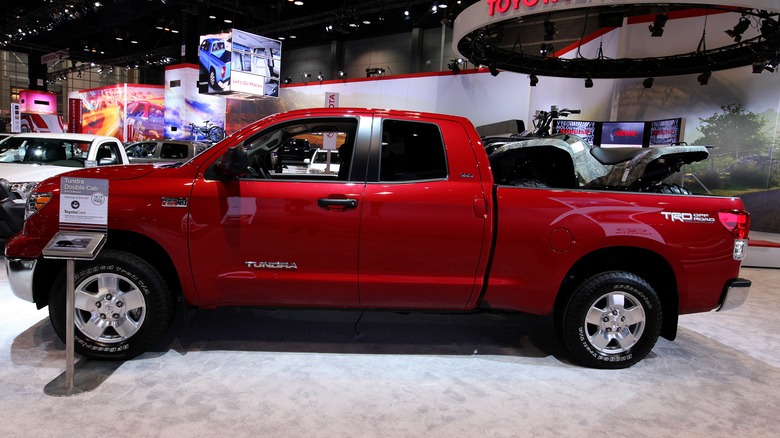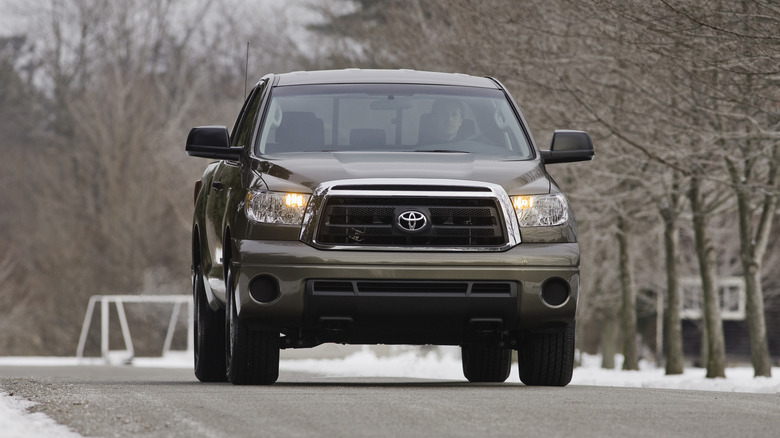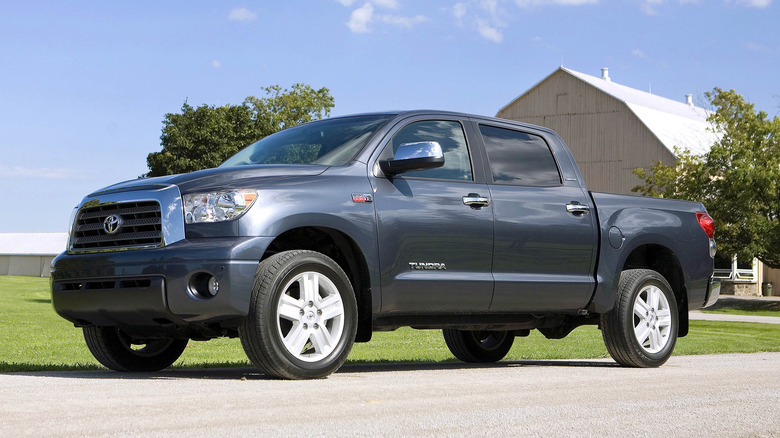The Best Years For Toyota Tundra (And Some To Avoid)
The Tundra was Toyota's first full-size pickup built in North America, and its 25-year history proves an enduring popularity. Since it hit the market in 1999, the Tundra has gone through three major generations. The first lasted from 2000 to 2006, while the second ran from 2007 to 2021. The third and current started with the 2022 model. Each generation is marked by updates and revisions to its predecessor, but individual model years still come with their own distinguishing characteristics. It's these year-specific characteristics that make some Tundra models superior to others.
If you don't care to compare every model year, you can follow a general consensus that the second-generation Tundra was the best so far. The first gen was pretty reliable overall, while the jury is still out on the current generation. Nonetheless, all three generations contain winners and losers.
Some Tundras are over 20 years old and still run like new, while a few model years have had enough red flags to place them on the "avoid-at-all-costs" list. These problems include recalls, customer complaints, and oor reliability ratings from publications like Consumer Reports. On the plus side, positive customer reviews and a low amount of negative feedback are good indications that a particular model year is worth its fair market value.
Should you seek to buy a Toyota Tundra, keep an eye out for the following model years.
Best: 2014
Although it's now surpassed double-digits in age, the 2014 Toyota Tundra continues to be one of the best full-size pickup trucks in North America. It emerged at the height of the Tundra's acclaimed second generation, and it still maintains a high overall reliability score of 78/100 from Consumer Reports and a 4.5/5-star rating on both Edmunds and Cars.com.
While the truck has aged well, it wasn't perfect. Some critics lamented the new bulky size and limited customization options, but after a decade on the road, customer satisfaction has remained consistently positive overall.
Owners frequently point to the vehicle's spacious interior, long-term reliability, and high price value as the biggest selling points. Such reliability and affordability are typical of Toyota brands, and the 2014 Tundra was no different. Unsurprisingly, it's a popular work truck for laborers in need of a powerhouse pickup that can take a beating.
The biggest gripe plaguing the 2014 Tundra is its poor fuel efficiency. Getting an average of 15 miles to the gallon, it manages to just fall short of the US Department of Energy's definition of a gas guzzler. However, fans might argue that gas costs are offset by the infrequent maintenance needs and budget-friendly cost. Its 2-door model's original retail price was $29,845, while its current Kelley Blue Book price hovers around $14,000. That could be a smart investment, since many owners claim the 2014 Tundra can run for 400,000 miles and beyond.
Best: 2021
The 2021 Tundra is far from an antique, so it hasn't had the same amount of time to accrue owner complaints as earlier models. It also helps that it was the final model year in the lauded second-gen, meaning it's benefitted from a decade-and-a-half of developments and improvements. Nonetheless, such advantages don't invalidate the 2021's near-perfect design.
Of course, nothing is perfect, but the 2021 Tundra's 4.7/5-star customer score on Cars.com is pretty close. On other review sites, it ranks just as high. J.D. Power gives it a "Quality & Reliability" rating of 86/100. Consumer Reports scores it 62/100 for overall reliability. Kelley Blue Book's consumer-score aggregate rates it at 4.4/5 stars, with 85% of owners recommending the 2021 Tundra. Those consistently positive responses on the top review sites help make this model year stand out as one of the best.
The stand-out features of the 2021 Tundra include its roomy interior, reliable V8 power, effective "Toyota Safety Sense" driver assist system, and impressive off-roading performance. It also boasts a "strong" resale value, likely thanks to its longevity that buyers can trust to deliver many thousands of miles of service.
The 2021 Tundra represents the culmination of all the best features of the second-gen, with few drawbacks. The only prominent complaint is the poor fuel economy, which averages out at 15mpg. That's consistent with the rest of the second-gen models, but it's still worth accounting for when considering your budget.
Best: 2022
The 2022 Tundra was the first of the new generation, so it had a lot riding on it. The third generation marked several fundamental changes to the Tundra blueprint. Notable updates include an improved rear suspension, enhanced safety features, and a multimedia system that supports Apple CarPlay, Android Auto, Amazon Music, and more. The biggest change, however, is the move away from a single V8 engine to two twin-turbocharged V6 engines. This switch brought the max tow capacity of third-gen Tundras to 12,000 pounds. Compared to the second-gen's max tow capacity of about 10,000 pounds, it's a noticeable boost in power.
All told, SlashGear's reviewers said the 2022 Toyota Tundra was better in almost every way. It retains the strengths of its predecessors, such as the comfortable, roomy interior, while improving on weak points, like the formerly limited infotainment. And although its large size might be intimidating, it manages to deliver smooth, easy handling. Overall, it's the same dependable full-size truck that so many Tundra owners love, with a few noteworthy improvements.
The most common complaint is fuel economy. Like previous models, it's something of a gas guzzler. The standard 4WD model gets a measly 19mpg according to FuelEconomy.gov, which is an improvement over the 2021 model's 14mpg average. But it's not great. Even the hybrid variant, the 2022 Toyota Tundra Capstone, manages only 20mpg.
Thus, if you can look past the middling fuel economy, the 2022 Tundra is a fantastic workhorse pickup truck.
Best: 2013
The 2013 Toyota Tundra is frequently lauded for its reliability, so investing in one even now, more than a decade since its release, is not a bad idea. In fact, it's the model year selected to represent the Tundra line on the list of the most reliable Toyota models ever built. It has a 4/5 rating on Consumer Reports for both reliability and customer satisfaction. It also won second place on U.S. News' ranking of 2013 full-size pickup trucks, with a score of 8.5/10. And just to drive the point home: J.D. Power gave it a perfect reliability rating of 5 out of 5.
So what makes the 2013 Tundra so dependable? The key to its "outstanding" reliability rating is likely thanks to its well-designed V8 engine. With potent V8 powertrains and a capable six-speed automatic transmission, it can perform the heavy-hauling tasks that you'd expect from a full-size pickup truck. Indeed, it does exactly what it's built for.
The lack of luxurious, high-tech features is the main complaint surrounding the 2013 Tundra. It has the Tundra's iconic spacious interior, but U.S. News' aggregated reviews point to the "fairly stiff ride quality" and a few "cheap cabin materials" as its biggest drawbacks. These are in contrast to the aforementioned top-notch reliability and excellent performance, so it's still one of the best Tundra models ever released.
Avoid: 2012
Considering the top-rated model years that surround it, the 2012 Toyota Tundra's poor reception might come as a surprise. It's the year that "won" the distinction of the worst Toyota Tundra model year to avoid, largely due to the sheer quantity of reported consumer complaints and the relatively high repair costs. Specifically, its air induction pump emerged as a huge problem, with many owners reporting failure around the 75,000-mile mark. Unfortunately, this component is costly to fix, at over $3,000 on average.
The 2012 Tundra's summary on Consumer Reports doesn't paint a pretty picture either. The 2012 model is said to be "one of the least refined and most dated... [its] ride is jittery." U.S. News confirmed this consensus, calling its ride "firm." Another mark against it comes from J.D. Power, which gave the 2012 model a reliability rating of 3/5. For a full-size pickup whose reputation is its reliability, this is a shockingly low score.
In short, the 2012 Tundra has all the drawbacks of the second-gen and nearly none of the positives. It has that lauded roomy interior, but the Tundra's specialty in reliability and affordability is simply lacking. Add to that the low mileage of second-gen Tundras and a knack for costly repair needs, it's probably best to avoid the 2012 model.
Avoid: 2007
The second-gen of the Tundra is often considered the best, establishing the brand as Toyota's "powerhouse" truck. But it had a shaky start. The 2007 Tundra kicked off the new design, and it was initially well-received for its affordable price. It also earned a 4/5 reliability rating from Consumer Reports, continuing the Tundra's reputation for dependability. However, problems began to emerge over time, with recalls and consumer complaints stacking up.
The 2007 Tundra has 14 recalls. The only other model year from the second-gen with a greater number of recalls is the 2010 model, with 16. But the specifics of the 2007's recalls are bad. The affected components include the steering, power train, wheels and tires, braking, and even a sticky accelerator pedal that could stay depressed. These serious issues compromise the safety of the vehicle. And because used car dealers aren't obligated to provide the recall history of a vehicle or fix known issues, buying a 2007 Tundra comes with extra risks.
By comparison, just a year later, the 2008 Tundra earned fewer recalls and fewer customer complaints according to the US Department of Transportation's database. This decline in negative feedback would continue with the 2009 model, as well, where customer complaints dropped from 379 to 316 to 38, respectively. Most notably, complaints surrounding the structure and suspension fell considerably with new model years. So, if you're presented with a choice between different model years, it's probably best to avoid the 2007 Tundra.
Our methodology for this list
We compare vehicles by relying on three main sources: Consumer Reports, the National Highway Traffic Safety Administration, and J.D. Power. These sites provide reliable aggregations of consumer reviews, professional testing results, and vehicle recall histories. By comparing the numbers of negative reviews, recalls, and alerts, we found which Toyota Tundra models were most successful and which were worth avoiding.
We also referred to several other sources to help round out our findings. U.S. News compiles press results for each model year to arrive at an overall rating. It also provides a comparison tool that places models side-by-side. Another reliable source is Edmunds.com, which performs professional testing. All of the above resources present owner reviews as well, where you can see individual feedback.
